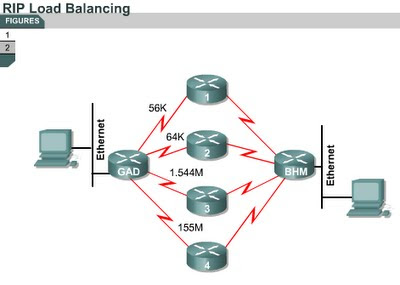Load balancing with RIP
7.2.8 This page will describe load balancing and explain how RIP uses this feature.
Load balancing is a concept that allows a router to take advantage of multiple best paths to a given destination. These paths are either statically defined by a network administrator or calculated by a dynamic routing protocol such as RIP.
RIP is capable of load balancing over as many as six equal-cost paths. The default is four paths. RIP performs what is referred to as “round robin” load balancing. This means that RIP takes turns forwarding packets over the parallel paths.
Figure shows an example of RIP routes with four equal cost paths. The router will start with an interface pointer to the interface connected to Router 1. Then the interface pointer cycles through the interfaces and routes in a deterministic fashion such as 1-2-3-4-1-2-3-4-1 and so on. Since the metric for RIP is hop count, the speed of the links is not considered. Therefore, the 56-Kbps path will be given the same preference as the 155-Mbps path.
The show ip route command can be used to find equal cost routes. For example, Figure is a display of the output show ip route to a particular subnet with multiple routes.
Notice there are two routing descriptor blocks. Each block is one route. There is also an asterisk (*) next to one of the block entries. This corresponds to the active route that is used for new traffic.
The next page will explain load balancing in greater detail.

Comments
Post a Comment